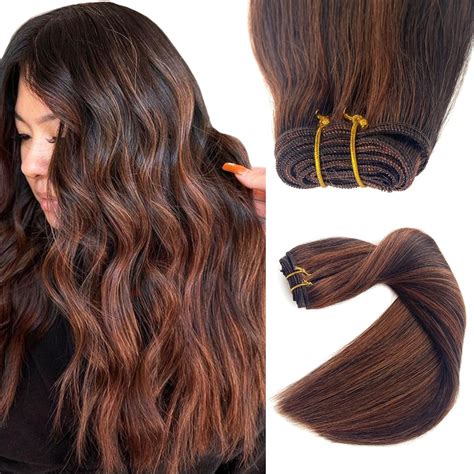What are Sew-In Hair Extensions?
Sew-in hair extensions are a method of attaching hair extensions to your natural hair by sewing them in. This technique provides a seamless and natural-looking blend, allowing you to add length, volume, and color to your hair.

Types of Sew-In Hair Extensions
1. Weft Extensions:
- Consists of a strip of hair sewn onto a thin fabric
- Most common and versatile type
- Available in various lengths, textures, and colors
2. Tape-In Extensions:
- Thin, flat hair wefts adhered to your natural hair using double-sided tape
- Less visible than weft extensions
- May cause damage to natural hair due to the tape
3. Micro-Link Extensions:
- Individual hair strands attached to your natural hair using beads or rings
- Natural-looking and long-lasting
- Requires professional installation and removal
Benefits of Sew-In Hair Extensions
- Natural appearance: Seamlessly blend with your natural hair
- Volume and length: Add significant volume and length to short or thin hair
- Color options: Experiment with different colors and highlights
- Styling versatility: Can be styled with heat tools, and hair products
- Long-lasting: Typically last for 6-8 weeks with proper care
How to Sew-In Hair Extensions
Materials:
- Hair extensions
- Thread and needle
- Curved needle or beading needle
- Measuring tape
- Hair comb
- Hair clips
Steps:
- Prepare your hair: Wash and blow-dry your hair straight. Create small sections.
- Section your hair: Divide your hair into rows, about 1-2 inches apart.
- Sew the extensions: Use a curved needle or beading needle to sew the hair wefts to your natural hair. Start at the back and work your way forward.
- Secure the stitches: Double-stitch each weft for added security.
- Blend the extensions: Use a hair comb to blend the extensions with your natural hair.
Common Mistakes to Avoid
- Over-washing: Too frequent washing can dry out the hair and cause it to mat.
- Excessive heat styling: Limit the use of heat tools to prevent damage.
- Improper installation: Get your extensions installed by a professional to ensure proper technique.
- Neglecting maintenance: Regular trims and treatments are essential for maintaining the health of your extensions.
- Sleeping with wet hair: Wet hair is more susceptible to breakage, so always dry your hair before bed.
Pros and Cons of Sew-In Hair Extensions
Pros:
- Natural-looking: Seamlessly blends with your natural hair color and texture.
- Long-lasting: Typically lasts for 6-8 weeks, longer than other methods.
- Versatile: Allows for many styling options, including heat styling and hair color treatments.
- Cost-effective: Less expensive than other extension methods, such as tape-ins or fusion.
Cons:
- Time-consuming: The installation process can take several hours.
- Requires professional installation: Improper installation can damage your natural hair.
- Can cause tension: The weight of the extensions can put stress on your natural hair follicles.
- Maintenance required: Regular trims, conditioning, and brushing are necessary to maintain their health.
6-8 FAQs about Sew-In Hair Extensions
- How long do sew-in hair extensions last? Typically 6-8 weeks, depending on your hair care routine and the type of extensions used.
- How much do sew-in hair extensions cost? Varies depending on the type of extensions, the length and quality of the hair, and the salon or stylist you choose.
- Do sew-in hair extensions damage my natural hair? If installed correctly and maintained properly, sew-in extensions should not cause any significant damage to your natural hair.
- Can I wash sew-in hair extensions? Yes, you can wash sew-in hair extensions, but use a gentle shampoo and conditioner specifically designed for extensions.
- Can I style sew-in hair extensions with heat? Yes, you can style sew-in hair extensions with heat, but use low heat settings and protect the extensions from direct heat by using a heat protectant spray.
- How often should I get sew-in hair extensions trimmed? Every 6-8 weeks to maintain the health and appearance of the extensions.
Ingenious Applications of Sew-In Hair Extensions
Beyond traditional hair augmentation, sew-in hair extensions have found innovative applications in various creative industries:
- Cosplay: Transform into fictional characters with vibrant or unusual hair colors and styles.
- Special effects: Create realistic hairpieces for movies and television shows.
- Fashion design: Showcase elaborate hairstyles on runways and in photo shoots.
- Drag performance: Amplify the impact of drag costumes with voluminous or eccentric hair extensions.
Tables for Easy Reference
Table 1: Types of Sew-In Hair Extensions
| Type | Description |
|---|---|
| Weft Extensions | Hair sewn onto a thin fabric strip |
| Tape-In Extensions | Thin, flat hair wefts adhered with double-sided tape |
| Micro-Link Extensions | Individual hair strands attached with beads or rings |
Table 2: Benefits of Sew-In Hair Extensions
| Benefit | Description |
|---|---|
| Natural appearance | Seamless integration with natural hair |
| Volume and length | Adds body and substance to short or fine hair |
| Color options | Experiment with different shades and highlights |
| Styling versatility | Can be styled with heat tools and hair products |
| Long-lasting | Typically lasts for 6-8 weeks with proper care |
Table 3: Common Mistakes to Avoid with Sew-In Hair Extensions
| Mistake | Description |
|---|---|
| Over-washing | Dry out the hair and cause matting |
| Excessive heat styling | Damages the hair |
| Improper installation | Can lead to tension and hair loss |
| Neg |
